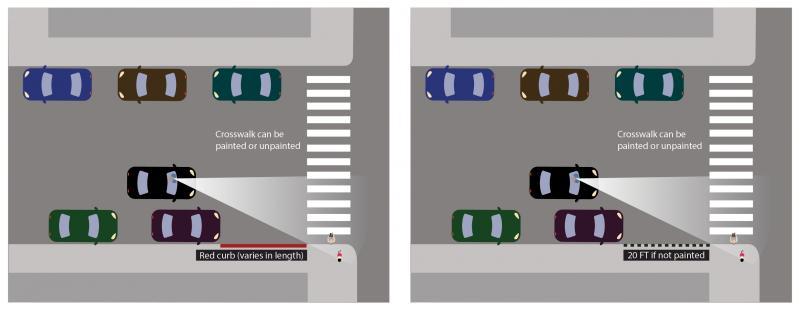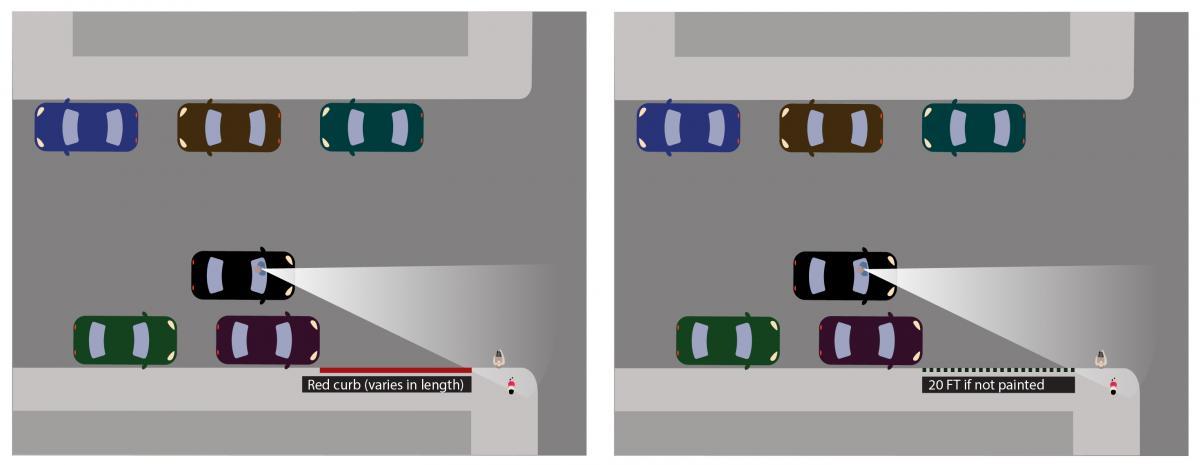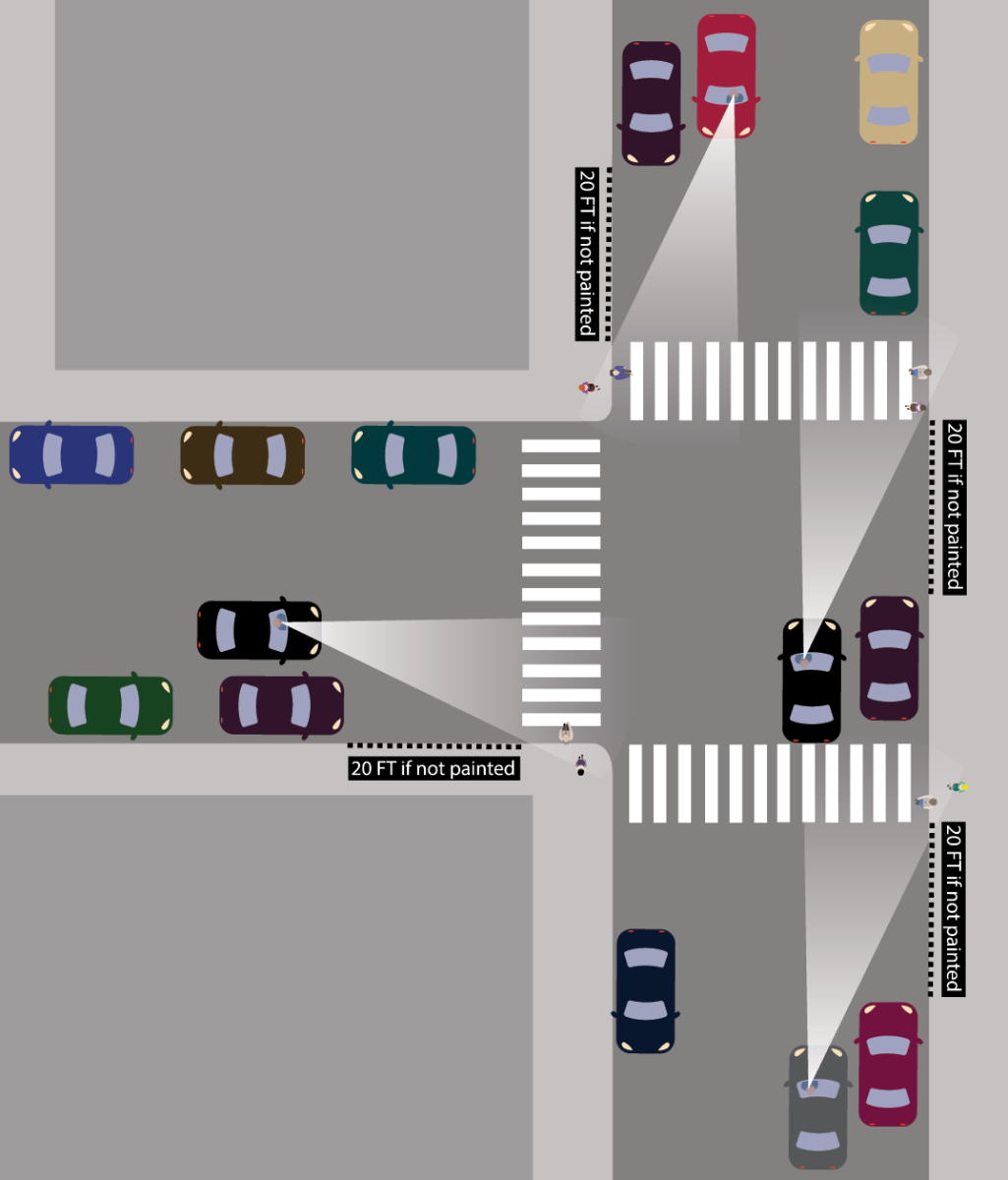Update: On February 10, 2025, the SFMTA announced its plan to enforce California's 'daylighting' law.
Starting in March 2025, the SFMTA will begin painting all curbs red where the state law requires daylighting to be implemented. This work should be completed within 18 months. School zones will be the first locations to be addressed.
On November 11, 2024, the SFMTA began issuing zero-cost warnings for vehicles parked within 20 feet of the approach side of crosswalks, marked or unmarked. The SFMTA will continue to issue warnings until curbs are painted red as part of fast-tracked, citywide program.
The SFMTA is doing this to comply with the statewide “Daylighting Law” (Assembly Bill 413), which went into effect on January 1, 2025. This law was passed to improve safety at intersections, especially for pedestrians, and it applies to all crosswalks, whether the crossing is painted or not.
What is daylighting?
Daylighting is the practice of improving safety at intersections by prohibiting parking next to crosswalks. By keeping the area next to crosswalks clear of parked vehicle obstructions, people walking and people driving or riding on the street can see each other better. Beginning January 1, 2025, remember to leave at least 20 feet (or one large car length) between a marked or unmarked crosswalk and your vehicle, so approaching vehicles can see pedestrians and bicycles.
How does it work?



These diagrams show how the clearance of 20 feet can make a big difference for street safety at crosswalks (above and middle), and at T-intersections (bottom).
Daylighting increases the visual field of both pedestrians crossing the street, and drivers pulling up to an intersection. The diagram above shows how much easier the extra space makes it to see the curbs and the entire crosswalk.
For pedestrians, daylighting means that they don’t have to venture into the intersection and peek around parked cars to see if they have a clear path to cross. This is especially important for children, who are less visible at intersections.
At the same time, drivers get a clearer view of the intersection and can easily see if someone is waiting to cross from well in advance. For more information on how visibility is essential to the safety of intersections, check out the research from the experts at the National Association of City Transportation Officials.
California’s New Daylighting Law (AB 413)
Starting on January 1, 2025, it is illegal in California to park within 20 feet of the approach of any marked or unmarked crosswalk, even if the approach does not have any red curbs painted. California Assembly Bill 413 was signed into law in October 2023 and replicates the law in other states that similarly require people not to park right next to any crosswalk. Specifically, the law:
- Creates a new section of the Vehicle Code, CVC 22500(n), which prohibits the stopping, standing, or parking of a vehicle within 20 feet of the vehicle approach side of any unmarked or marked crosswalk or 15 feet of any crosswalk with a curb extension anywhere in California.
- On a two-way street, only the space on the right-side approaching a crosswalk as one is driving is affected. However, on a one-way street, both the left and the right curb areas 20 feet from the crosswalk are no parking zones.
- Allows local jurisdictions to paint zones that are longer or shorter than 20 feet. When you see a red curb or parking prohibition sign next to a crosswalk just follow that distance. If there is no paint or signs, the 20 feet distance applies. 20 feet is about the length of a standard parking space or one large car-length.
Historical Context for California’s New Parking Rules Near Crosswalks
Until AB 413 was signed into law in October 2023, California was one of the few states that did not have a rule restricting parking near crosswalks. Over 40 states currently have laws that require vehicles to keep a distance of generally 20 feet from crosswalks, according to research from the California Research Bureau of the California State Library. These rules often date back to the dawn of the automobile era when codes were first established to regulate the operation of motor vehicles.
The United States Uniform Vehicle Code (UVC) adopted in the 1920’s originally had an Article 26 that prohibited parking “within twenty-five feet from the intersection of curb lines or if none then fifteen feet of the intersection of property lines at an intersection of highways.” The UVC was later updated and in its most recent Millenium version has Section 11-1003(a)(2)(c) that prohibits parking “within 20 feet of a crosswalk at an intersection.” Since most states based their own first Vehicle Codes on the UVC, these rules have carried forward over time across the United States.
The federal government itself assumes UVC rules in its guidance on how cities should arrange on-street parking spaces. Here’s a video from Salt Lake City, for example, explaining driving rules in Utah that are similar to those that now apply in California, except in Salt Lake City one also has to keep clear of the departure or far-side crosswalk. California, however, did not base its first California Vehicle Code on the UVC, thus never had nor later added a prohibition prohibiting parking near intersections or crosswalks. Therefore, while the daylighting concept is new to many of us in California, the concept that it is safer to keep parked vehicles away from intersections is as old as the automobile itself.
Across the world, many other countries also have rules that require drivers not to park within a specified distance of marked or unmarked crosswalks. The 1968 Vienna Convention on Road Traffic (which sets the driving rules for many countries, particularly in Europe) states in Article 23 that parking should be prohibited “on approaches to level-crossings, to intersections, and to bus, trolleybus or rail-vehicle stops within the distances prescribed by domestic legislation.” The distance varies, but in many countries has been set at 5 meters or about 16 feet. When visiting other countries and states, you may now find that they too have had AB 413-type parking rules. So now, whether you are traveling in or out of California, always exercise care when parking near crosswalks and intersections.
SFMTA’s Commitment to Daylighting
In May 2019, the San Francisco Board of Supervisors adopted a resolution urging the SFMTA to create a daylighting plan and to systematically implement daylighting on the High Injury Network. SFMTA is committed to daylighting the entire High Injury Network—the 12% of city streets that account for 68% of severe and fatal traffic crashes. This effort is part of our overall Vision Zero commitment to eliminate traffic fatalities and reduce severe injuries on our city streets. In addition, many other intersections in the city have had red zones added to them over the years to improve safety as well.